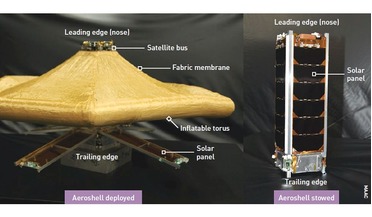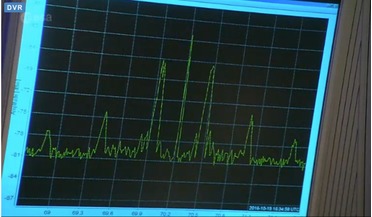 February 2020
Aeroshells – from LEO to Mars
February 2020
Aeroshells – from LEO to Mars
... suitable for an ISS down-mass capability. Aeroshells also have potential for easier interplanetary transportation in that ‘aerobraking’ could be used to slow a spacecraft down as it enters the atmosphere of its target planet. International and cross...
 December 2014
MAVEN and the evolution of Mars
December 2014
MAVEN and the evolution of Mars
... activity and surface influences, including dust storms, can improve satellite atmospheric entry, drag and aerobraking calculations. The ionosphere’s variability can affect surface-to-ground, ground-to-surface and surface-to-surface communications...
 June 2015
Beagle 2: discovering the lost Mars lander
June 2015
Beagle 2: discovering the lost Mars lander
... ground at 16 metres/second, took a little less than 8 minutes. During that time, Beagle 2 was slowed by a combination of aerobraking, a 1.9 metre drogue parachute and a 10 metre main parachute, all under the control of the probe’s software. The...
 January 2017
Elon Musk and Mars - looking for a snowball effect
January 2017
Elon Musk and Mars - looking for a snowball effect
... transport. Crewed Mars landing craft would then be based on decades of experience with lunar landings and with aerobraking and supersonic retro-propulsion at Earth. In other words, instead of an all-or-nothing push to Mars with new, purpose...
 09 March 2016
Components of ExoMars 2016 come together in preparation of launch next week
09 March 2016
Components of ExoMars 2016 come together in preparation of launch next week
... missions to Mars by performing a controlled landing on the planet’s surface. Schiaparelli is thus designed to be slowed down by aerobraking and the deployment of a parachute at an altitude of about 11 km. A thruster system will also slow its descent...
 19 October 2016
Success for TGO orbit insertion and its looking good for Schiaparelli too
19 October 2016
Success for TGO orbit insertion and its looking good for Schiaparelli too
.... Meanwhile, the Trace Gas Orbiter (TGO), if confirmed to be in the right orbit, will now complete a year of complex aerobraking manoeuvres to circularise its orbit and its science mission will start at the end of 2017. It will also...